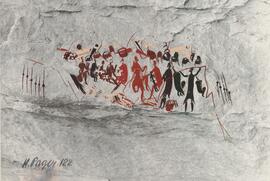HPC HPC-RARI-HPC-01-146HC.jpg
·
Item
Part of Pager, Harald
P122 pager F343.
Bushman beliefs suggest that bags had a special significance beyond everyday use. Their relation to trance metaphors is illustrated in San mythology, where parallels were drawn between getting into a skin bag and getting into an animal- that is, taking on its potency. Therefore, bags painted next to a dance or by themselves, are probably an indication of a trance experience.
Quivers are usually made of bark and are used to store arrows. The quiver, bow and other pieces of equipment were carried on a hunting bag, which is wider at one end than the other and which has a thong running its length so that it can be slung over a shoulder. RARI











